Prostitution has been called “the oldest profession in the world.” Whether or not that’s true is up for debate, since the term “the oldest profession in the world” wasn’t coined until the late 1800s, in, of all things, a Rudyard Kipling story. And Oldest.org, which lists, well, old things, doesn’t even include it in its list of the top ten oldest professions in the world. But it’s obvious that prostitution is out there and has been for a long, long time.
Oh, and just as a side note, prostitution is not limited to humans. Just as homosexuality has been observed in the non-homo sapien animal world, so has prostitution. Like it or not, both are as natural as can be.
When adults travel
I’ll be honest…it’s not mine or yours or anyone else’s to judge how someone spends their time when they travel. As far as I’m concerned, if that includes anything having to do with sex (or even nudity), as long as everyone involved is a legal adult and no one is getting physically or emotionally hurt, more power to them. That’s why we’ve written in the past about:
- Countries where it’s legal to have public sex
- The naughtiest adult only hotels & resorts in the world
- The cruise lines that allow topless and nude sunbathing
But swinging back to prostitution, yeah, let’s face it…some people actively seek out sex workers when they’re out of town (and sometimes when they’re in their home town). The thing is, prostitution is legal in some countries, illegal in others, and “complicated” in still other countries.
The map
Trying to find a map of the countries where prostitution is legal, that’s 100% accurate, is…difficult. Laws do change so a recent map is needed. But even then, particularly in countries where the laws vary by where you are in the country (the U.S. is a good example – prostitution is illegal in 49 states but is legal, albeit with some caveats, in 10 counties in Nevada [and in another state too, but we’ll get to that in a bit]), there are different interpretations. So if this map, culled from Wikipedia and public domain, is not 100% correct, sorry…I did the best I could.
The Laws by Region
North America
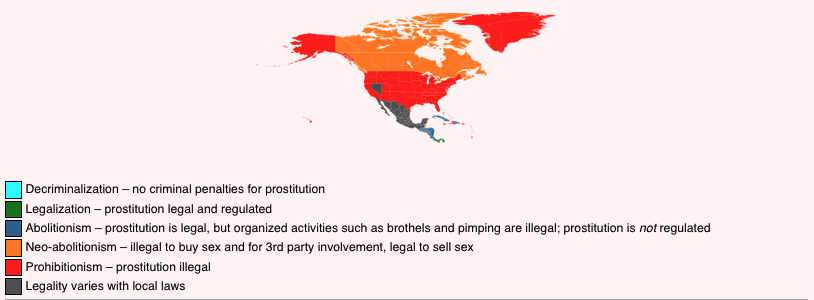
Central America & the Caribbean
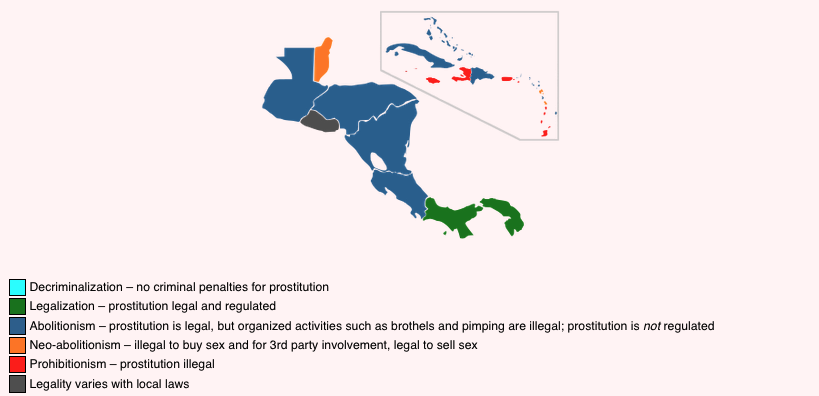
South America
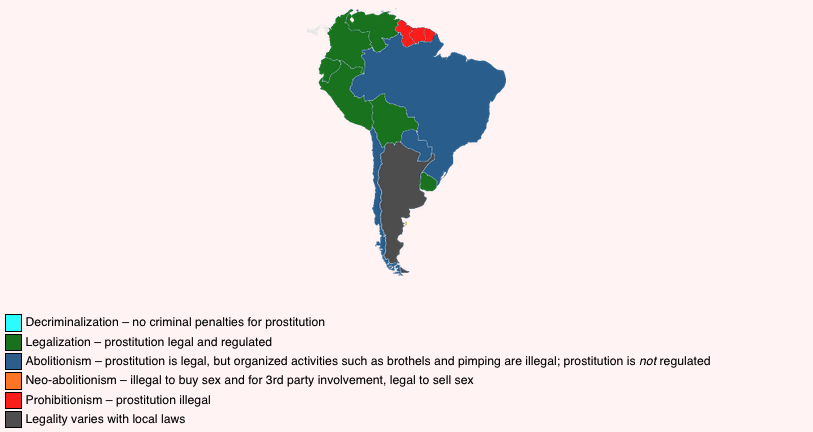
Europe
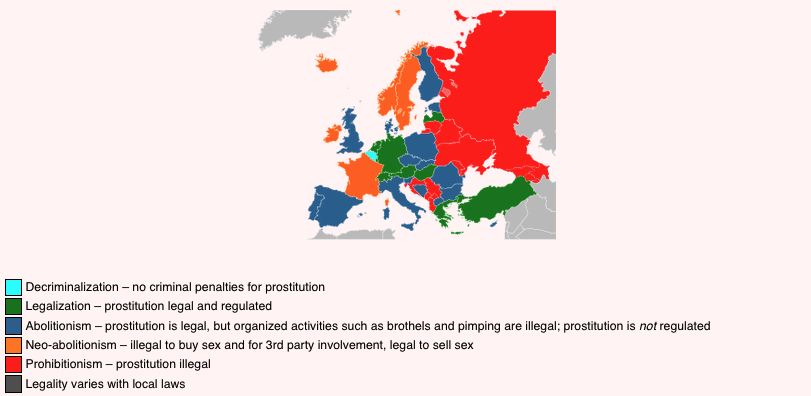
Asia
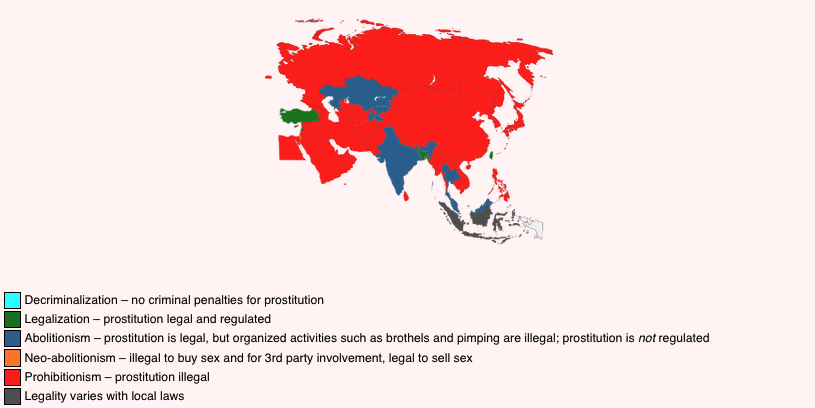
Oceania
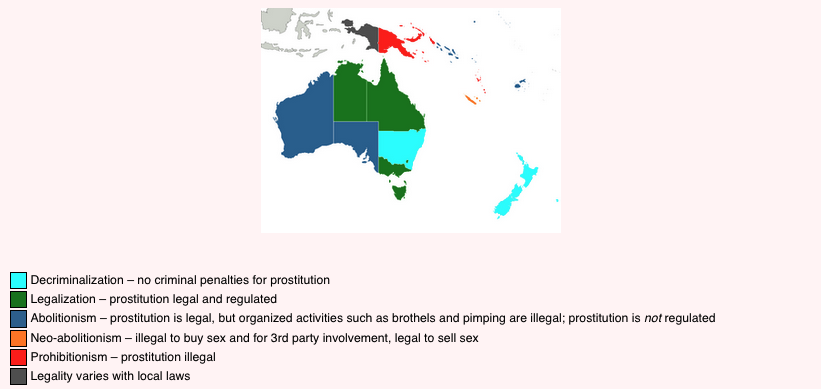
Africa
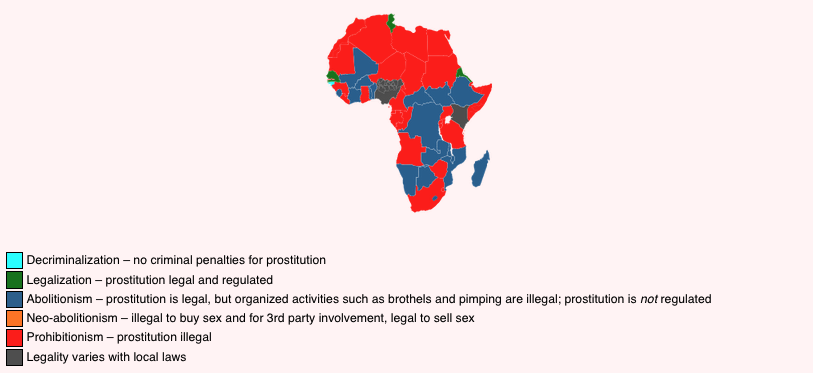
What the Colors Mean
Light blue – Decriminalized
Selling, buying, organizing, and solicitation of sex are all legal (or for some, they’re just not addressed in the law, period) and are subject to minimal or no special regulations.
Dark green – Legalized, but regulated
Selling, buying, and some forms of organizing (read: brothels) and soliciting of sex are legal. But they’re also regulated. So, as examples, they may require prostitutes to be registered, or they may only allow prostitution in certain districts.
Dark blue – Abolitionism
Selling sex and buying sex are both legal. But to help prevent exploitation of the sex worker, they usually prohibit public solicitation, the operation of brothels, and forms of “organization” (read: pimping, procuring, and forced prostitution). This approach, where prostitution is not regulated, is the most prevalent worldwide
Orange – Neo-abolitionism
This philosophy considers prostitution to be violence against women. Selling sex is technically legal, but buying, organizing, and soliciting sex are all illegal. Prostitutes are considered legally blameless when caught in the act, but their clients and pimps (the prostitute’s “organizer” or boss) are prosecuted. This “reverse loophole” is designed to suppress demand.
Red – Prohibited
Prostitution is illegal (prohibited/criminalized) across the board. Selling, buying, organizing (via brothels, pimps, etc), and soliciting sex for money are all against the law. This approach is common in deeply religious countries and countries that may not be particularly religious but still hold onto puritanical outlooks, especially countries where pornography is outlawed.
Dark gray – legality varies with local laws
Since most of our readers live in the U.S., we’ll bring up Nevada again. Prostitution is illegal everywhere in the U.S. except for 10 counties in Nevada. It’s a lesser known fact (and apparently unknown by the person(s) who made the maps above) that Maine has also decriminalized prostitution, but only for adults who sell sexual services, not for buyers (here’s why they did it).
Fun Facts About Prostitution
Prostitution may be illegal in certain places, or maybe be legal with some caveats – but there are ALLL sorts of ways people get around the law. Here are a few, along with some interesting country-specific information:
- A survey in Australia (where some states have decriminalized prostitution, some have abolitionism on the books) suggested that clients in regulated environments are more likely to use protection, thereby reducing STDs, compared to those soliciting sex illegally.
- In Austria, sex work is legal and taxed, providing significant state revenue and licensing opportunities
- In Brazil, brothels disguise themselves as nightclubs. Client reportedly enters the nightclub and talks to a girl. Girl pressures client to buy her a (very overpriced) drink. Client takes girl to a room that the “nightclub” conveniently rents out. Client pays girl in cash in the room, so it’s off the books and the “nightclub” has plausible deniability. Girl is most likely shaken down later for a cut.
- Canada has a similar system to Brazil, but it’s “bodyrub massage” spas that get special licenses from the government.
- The Silver Cross Tavern, a pub, in London, England, is argued to be the only theoretically legal (albeit non-operating) brothel in the country, on the grounds that a 17th-century royal license on the building, granted by Charles I, was never revoked.
- One of the duties of the medieval English justice Richard Herriard (d. 1208) was to pay prostitutes for King John of England.
- 18th century English prostitute Sally Salisbury was sent to prison after a riot but was released by a judge who was infatuated with her.
- Prostitution is legal in Finland, but brothels and pimping is illegal. “Basically you need to be a free agent prostitute,” said one resident. Finland’s laws about prostitution are similar to the laws of other countries – it’s legal, but using third parties is illegal.
- Before becoming King of the United Kingdom, Edward VII was a frequent visitor to the luxurious Belle Époque brothel Le Chabanais in Paris, France and had himself built a special “love seat” there.
- Sex workers in Germany are awarded with health and safety protection.
- Prostitution is illegal in Japan, but there are areas well known where paid sex workers can be found by locals and tourists alike (here’s an example). There are also legal loopholes in Japan (soaplands, kyabakura, red-light districts, etc.) where prostitution is allowed to thrive. Remember that adults only theme park in Tokyo that we told you about? Yeah….
- In Iran, Iraq and Bahrain, prostitution is officially illegal, but you can go to a mullah () with a prostitute and enter into a temporary marriage. Said marriage is automatically finalized after a specified amount of time.
- In Israel, sex work is generally illegal, but some municipalities allow licensed brothels.
- In Italy, prostitution is legal in designated areas, but outside these zones, it remains illegal, creating a complex legal landscape.
- The area around La Merced Market, in Mexico City, is considered to be a “tolerance zone” for prostitution.
- Prostitution is legal in New Zealand. Kiwi taekwondo practitioner Logan Campbell opened a brothel in 2009 to fund his bid to compete at the 2012 Summer Olympics. His backers included his parents.
- Norway and Sweden have both criminalized the purchase of sex (but not the selling), leading to a reduction in street prostitution.
- Prostitution may be illegal in the United States, now, but it was legal in most states until the early 20th century. With that, we have a LONG history of brothels:
— In Texas, San Antonio’s Sporting District, one of the largest red-light districts in the U.S. in the early 1900s, was so large that a tourist guide was published for visitors.
— the Bozeman Carnegie Library was intentionally built across from Bozeman, Montana‘s red-light district and opium dens.
— Hacienda Arms on the Sunset Strip was the “most famous brothel in California” in the 1930s and now houses a celebrity-owned restaurant described by Newsweek as “so hip it hurts.”
— Minneapolis used to have 3 red-light districts. One bordello, built by famed madame Ida Dorsey, is still standing today.
— the Chatham Garden Theatre in New York City went from being a haven for prostitution to a Presbyterian chapel in the span of one year.
— The the Dumas Brothel, located in Butte, Montana, was the longest-operating brothel in the United States. It’s still standing and is believed to be haunted.
— The mayor of Gloucester, Massachusetts, John S. Pearson, used to lead raids on the city’s brothels while the City Marshal was otherwise engaged.
— Three-Mile Hog Ranch was a center for prostitution for soldiers at Fort Laramie.
— Portland Oregon‘s the Admiral Apartments, built in 1909, had “sporting girls” (prostitutes) operating out of it by 1913.
— Louisiana sheriff Cat Doucet of St. Landry Parish apparently obtained his nickname from his practice of protecting illegal “cathouses” ( a slang term for brothels).
— Clam juice and aspirin were served at Chicago‘s Everleigh Club brothel as a starter for breakfast (which, it should be noted, began at 2:00 in the afternoon).
— Madame Anna Wilson, the “Queen of the Underworld” in early Omaha, Nebraska, bequeathed her 25-room brothel mansion to the city to use as an emergency hospital upon her death.
— Due to an accidental legal loophole, prostitution in Rhode Island was decriminalized in 1980, under certain circumstances, until 2009.
Here are some interesting “general interest” facts about prostitution, courtesy of Gitnux and others:
- In 2020, estimates suggest there are about 4.4 million sex workers globally, including both legal and illegal contexts.
- Legalized prostitution generates about $186B per year, worldwide.
- The average age of entry into sex work in legalized regions ranges from 16 to 20 years old (reminder for people from the U.S.: “being of age” varies from country to country. 16 is an adult in some places).
- Approximately 70% of sex workers in legal settings are female, with the rest being male or transgender, according to various health surveys.
- The median monthly income for sex workers in legally regulated environments can range from $2,000 to $5,000, depending on the country and services offered.
- A 2019 survey reported that 70% of sex workers in legal settings felt safer than those working illegally.
- The proportion of minors involved in prostitution is significantly lower in jurisdictions where sex work is legalized and well-regulated, according to reports from UNICEF.
- About 11.7% of sex workers are HIV+ – that’s about 13 times higher than the general population.
- People who have grown up where prostitution was legal, and especially who grew up near brothels, consider them to be “normal” (one quote: “I remember as young as 4 years I used to wave at them and they would always wave back and smile, so in my school we coined them “the happy ladies”). As opposed to places where they’re illegal and locals would “clutch the pearls” at having a “wh**ehouse” near them.
Final Thoughts
And that may be more than you ever knew, or wanted to know, about prostitution. You’re welcome.
Want to comment on this post? Great! Read this first to help ensure it gets approved.
Want to sponsor a post, write something for Your Mileage May Vary, or put ads on our site? Click here for more info.
Like this post? Please share it! We have plenty more just like it and would love it if you decided to hang around and sign up to get emailed notifications of when we post.
Whether you’ve read our articles before or this is the first time you’re stopping by, we’re really glad you’re here and hope you come back to visit again!
This post first appeared on Your Mileage May Vary
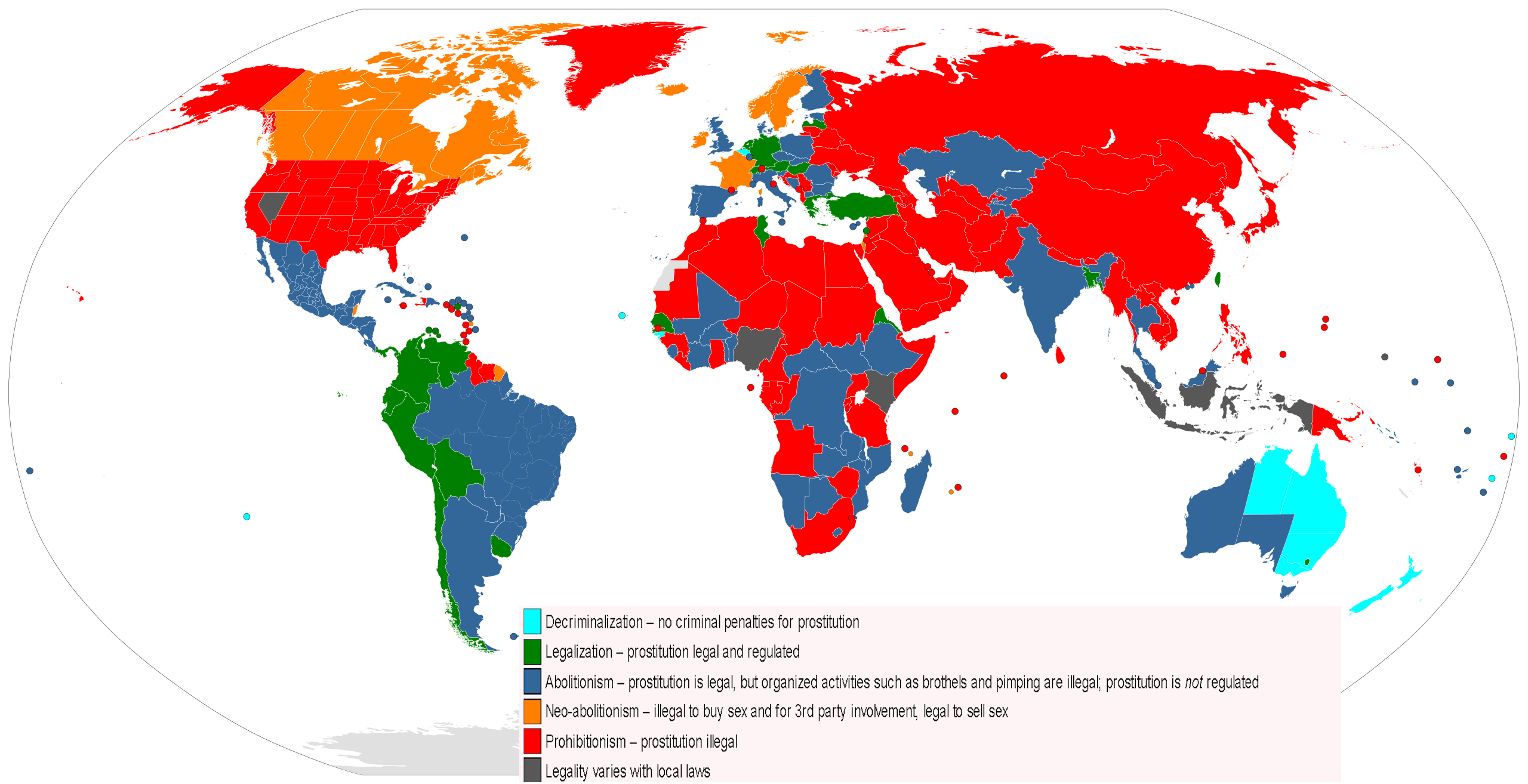

1 comment
My mom was Swiss. I recall many times where she would talk to Americans about a city and with a shrug mention something like “some girls” working in the area but would not accost you. A lot of Europeans don’t have that awful puritanical streak we do. Maybe it’s from having so many different countries with different views and cultures in such close proximity.